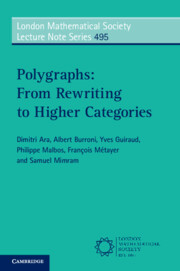Refine search
Actions for selected content:
115 results
Higher incoherence of the automorphism groups of a free group
- Part of
-
- Journal:
- Proceedings of the Royal Society of Edinburgh. Section A: Mathematics , First View
- Published online by Cambridge University Press:
- 01 September 2025, pp. 1-28
-
- Article
-
- You have access
- Open access
- HTML
- Export citation
8 - Situating The Rite of Spring within Stravinsky’s Compositional Oeuvre
- from Part II - Contexts
-
-
- Book:
- The Cambridge Companion to <i>The Rite of Spring</i>
- Published online:
- 28 June 2025
- Print publication:
- 17 July 2025, pp 173-188
-
- Chapter
- Export citation
COHERENCE OF MULTIPLIER SUBMODULE SHEAVES ON GENERIC COMPLEX TORI
- Part of
-
- Journal:
- Nagoya Mathematical Journal , First View
- Published online by Cambridge University Press:
- 30 June 2025, pp. 1-8
-
- Article
- Export citation
Chapter 14 - Integration
- from Part V - Integration and Conclusion
-
- Book:
- The Development and Organization of Meaning
- Published online:
- 11 June 2025
- Print publication:
- 26 June 2025, pp 187-200
-
- Chapter
- Export citation
Chapter 6 - The Preschooler
- from Part II - The Growth of Meaning
-
- Book:
- The Development and Organization of Meaning
- Published online:
- 11 June 2025
- Print publication:
- 26 June 2025, pp 67-84
-
- Chapter
- Export citation
10 - Reason, Philosophy, and Character
-
- Book:
- Neil MacCormick
- Published online:
- 22 May 2025
- Print publication:
- 12 June 2025, pp 497-565
-
- Chapter
- Export citation
Title 6 - The Hermeneutics of International Human Rights Organs
- from Part III - The Interpretation of International Human Rights Law
-
- Book:
- International Human Rights Law
- Published online:
- 10 April 2025
- Print publication:
- 01 May 2025, pp 441-472
-
- Chapter
- Export citation
Part III - The Interpretation of International Human Rights Law
-
- Book:
- International Human Rights Law
- Published online:
- 10 April 2025
- Print publication:
- 01 May 2025, pp 439-1066
-
- Chapter
- Export citation
Title 2 - Normative Pluralism in International Human Rights Law
- from Part I - Foundations of International Human Rights Law
-
- Book:
- International Human Rights Law
- Published online:
- 10 April 2025
- Print publication:
- 01 May 2025, pp 41-110
-
- Chapter
- Export citation
8 - Reasoning with Probability: Bayesianism
- from Part II - Ongoing Investigations
-
- Book:
- An Introduction to the Philosophy of Science
- Published online:
- 29 March 2025
- Print publication:
- 27 March 2025, pp 153-183
-
- Chapter
- Export citation

Polygraphs: From Rewriting to Higher Categories
-
- Published online:
- 18 March 2025
- Print publication:
- 03 April 2025
Discourse comprehension and referential processing: effects of contextual distance and semantic plausibility on presupposition processing
-
- Journal:
- Language and Cognition / Volume 16 / Issue 4 / December 2024
- Published online by Cambridge University Press:
- 10 October 2024, pp. 2032-2054
-
- Article
-
- You have access
- Open access
- HTML
- Export citation
Chapter 10 - Implications of ECT for Research Methodology
-
- Book:
- The Nature and Nurture of Talent
- Published online:
- 20 June 2024
- Print publication:
- 27 June 2024, pp 215-238
-
- Chapter
- Export citation
Chapter 4 - Socrates and Coherent Desire (Gorgias 466a–468e)
-
-
- Book:
- Plato's Gorgias
- Published online:
- 25 May 2024
- Print publication:
- 30 May 2024, pp 68-86
-
- Chapter
- Export citation
6 - Decoherence and Collapse
- from Part I - A Nonmathematical Exposition of Quantum Mechanics and Quantum Field Theory
-
- Book:
- Interpreting Quantum Mechanics
- Published online:
- 09 May 2024
- Print publication:
- 16 May 2024, pp 75-92
-
- Chapter
- Export citation
14 - Transition Rules
- from Part III - A Short Course in Quantum Field Theory
-
- Book:
- Interpreting Quantum Mechanics
- Published online:
- 09 May 2024
- Print publication:
- 16 May 2024, pp 201-218
-
- Chapter
- Export citation
WHEN NO PRICE IS RIGHT
- Part of
-
- Journal:
- The Review of Symbolic Logic / Volume 18 / Issue 1 / March 2025
- Published online by Cambridge University Press:
- 14 May 2024, pp. 99-141
- Print publication:
- March 2025
-
- Article
-
- You have access
- Open access
- HTML
- Export citation
Restoring Dialogical Rule of Law in the European Union: Janus in the Mirror
-
- Journal:
- Cambridge Yearbook of European Legal Studies , First View
- Published online by Cambridge University Press:
- 02 April 2024, pp. 1-16
-
- Article
-
- You have access
- Open access
- HTML
- Export citation
2 - The Offshore Environment
-
- Book:
- Offshore Wind Energy
- Published online:
- 07 March 2024
- Print publication:
- 14 March 2024, pp 11-76
-
- Chapter
- Export citation
‘I’m a fighter and I do not give up’ – Socially isolated older adults’ experiences with meaning in life
-
- Journal:
- Ageing & Society / Volume 45 / Issue 5 / May 2025
- Published online by Cambridge University Press:
- 01 March 2024, pp. 879-900
- Print publication:
- May 2025
-
- Article
-
- You have access
- Open access
- HTML
- Export citation









